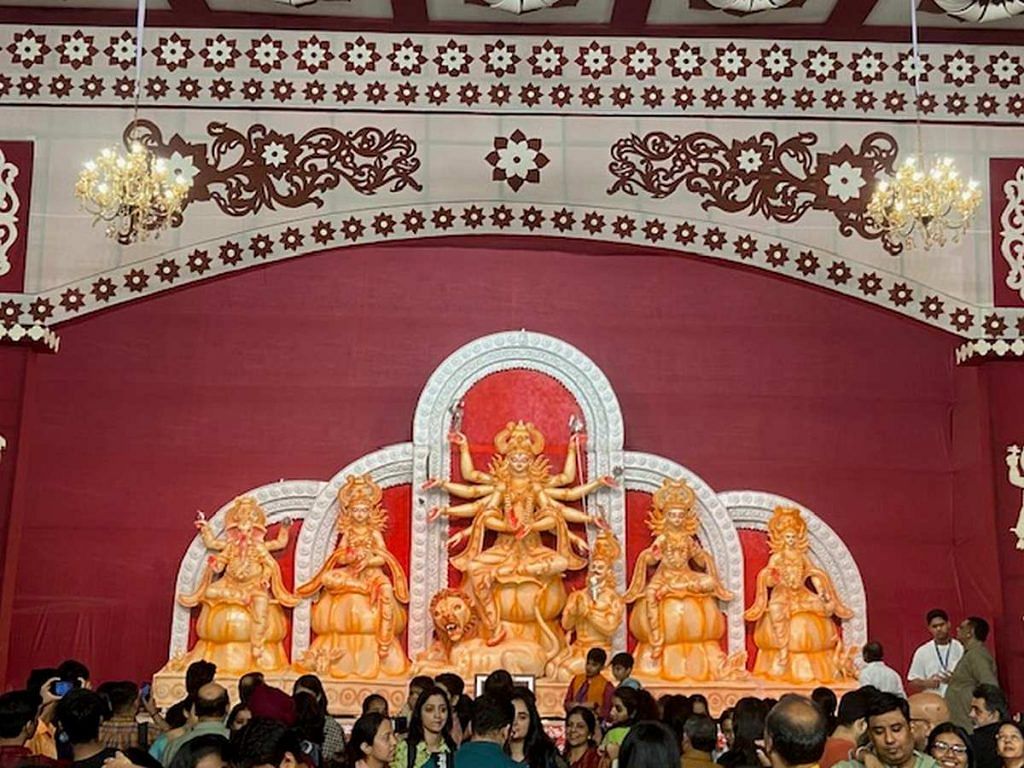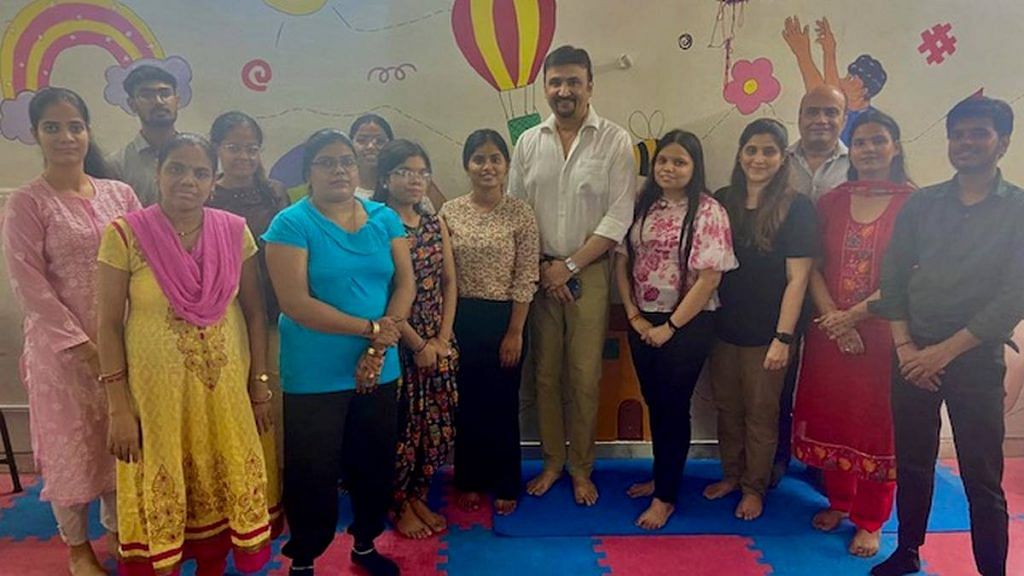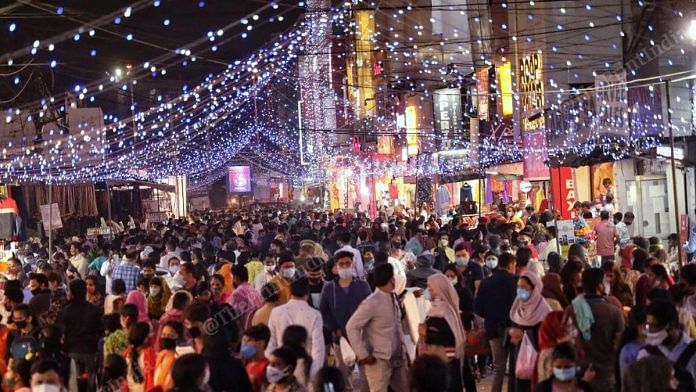New Delhi: Religion is for everyone. Except when it’s not. Festivals are lauded as religious and cultural celebrations with the power to bind people together, but this isn’t always the case. Instead, the festival season can be a time when certain groups of people are consistently ignored and excluded.
The absence of wheelchair ramps at entrances to festival spaces, or judgmental stares when a child with sensory issues becomes overwhelmed at a noisy Durga Puja pandal, send a clear message: Not welcome.
“Please confine them,” is the indirect signal that festival organisers send to parents of children with neurological developmental disorders, says Rajeev Bhatt, author of Decoding Autism and founding director of the Adhyayan Inclusive Learning Centre.
For people with physical disabilities, barriers to access are a fact of life that other people do not think about twice. “They have been left out,” says Nipun Malhotra, a disability rights activist.
There are diverse disabilities and each person’s experience is unique, but the exclusion is universal. For the most part, festivals as enactments of unity exist only in the realm of the imagination.
While there is greater awareness of accessibility and some genuine efforts to promote inclusion, festival organisers’ efforts to include people with disabilities in festivities have not been good enough.
This is not limited to Hindu festivals or sites of worship. Arman Ali, a disability rights activist, explains that restricted accessibility is a problem across all religions in India. “Disability continues to remain an afterthought,” he says.
When he was visiting the Ajmer Sharif Dargah in Rajasthan, Ali was asked by staff to use a wheelchair that they would provide. The problem was that it was broken.
Also Read: Disability influencers on Instagram have one loud message. They don’t exist to inspire you
Diwali melas with a difference
People in wheelchairs can browse, shop, and snack easily at the Diwali melas at the Blind Relief Association, Select CityWalk Mall, and Dilli Haat, all of which take place on just one level.
Among these melas, the Blind Relief Association has gone the extra mile to include people with disabilities.
At their popular Blind School Diwali Mela, the grass on which the stalls are laid out has been covered with tarpaulin to provide a less bumpy surface, and the extension space, the Gandhi Hall, is also wheelchair-accessible.
One of the best things about the #Diwali Mela at the Blind Relief Association is the foot massage. Do get one if you're there. And a good conversation to go with it. pic.twitter.com/yQLgHDKZWZ
— Bhavani Giddu (@bgiddu) October 20, 2019
The mela is not just inclusive to visitors but vendors too. From visually impaired masseurs offering relaxing massages in their booths to blind employees brewing coffee at the complex’s Echoes Café, people with disabilities are equal participants in the Diwali festivities.
Inclusion as tokenism?
Durga Puja organisers in Delhi’s Chittaranjan (CR) Park say they prioritise accessibility, but people with disabilities often find that the reality falls short. Barriers persist, exposing a gap between promises and actual inclusion.
Sayan Acharya, executive committee member of the Durga Puja Samiti of CR Park’s B Block Ground, says that the entire area is wheelchair-accessible, including the washrooms. Rather than staircases, ramps provide access to the pandal, while wheelchairs are also available for those who need them. However, he clarifies that he can only speak for his pandal.
At the Kali Mandir Society, which has been hosting pujas for more than 50 years, general secretary Prodip Ganguly asserts that every puja committee in CR Park has a disabled person as member, although he does not provide specific details.
Despite its five-decade run as a major puja venue, Kali Mandir has no ramps for disabled access.

Child psychologist Songjukta Bagchi points out that the only way to reach the stage in front of the idol is to climb a staircase. This also prevents physically handicapped children from participating in cultural performances. “It’s a mockery to a child who is using some sort of external support for physical disability,” she says.
When activist Nipun Malhotra went to CR Park for Durga Puja in 2022, there were no separate lines for those in wheelchairs hoping to see the idol and say their prayers. In light of this experience, he says he did not attend pujo at CR Park this year. Despite organisers insisting that they’ve done their best, people with disabilities are left feeling excluded.
Alim Chandani, Mission Leader of EnAble India’s Hear A Million project to empower the deaf community, says that deaf people like him face major communication barriers at cultural events.
The challenge is so great that many deaf people are discouraged from attending festivals. “It leads to a sense of exclusion from the broader community,” he says.
To fix issues such as this, Malhotra suggests that festival planning committees should have members with disabilities.
Across the world, religion is important and India is no different. As Bhatt points out, when people face difficulty in life, they often turn to God.
For people with disabilities, religion can become a lifeline since society has marginalised them, says Malhotra. “Religion is something you can hold on to tightly,” he adds.
Yet, people with disabilities have fewer opportunities to participate in religious activities. “If you’re not part of the festivity, then you’re isolated,” says Ali.
‘What’s wrong with your child?’
The Rights of Persons with Disabilities Act 2016 expanded the range of conditions classified as disabilities. Neurological and developmental conditions like autism, cerebral palsy, and Down syndrome are now also included in the ambit of the law.
According to Malhotra, this legislation mandates that all public spaces be accessible, but the ongoing conversations on the subject even seven years later suggests that the legislative promise has not been fulfilled in practice.
“Mindset is the problem,” says Bhatt. As the director of the Adhyayan Inclusive Learning Centre in South Delhi, he helps children with autism succeed academically and socially, with some alumni going on to study at top British universities. He points out though, that as children, these alumni would not have been welcomed with open arms at Delhi-NCR’s festive gatherings.
Festivals in India tend to be crowded and chaotic, and some children on the autism spectrum can feel claustrophobic and overwhelmed. Some may shout out in distress. Bhatt says others would not be caring, but instead ask: “What’s wrong with your child?”
Bhatt’s current research focuses on sensory issues, which can include discomfort from loud noises or irritation from a shirt label, among many other things. Yet, festival organisers are unlikely to have even heard of the concept, Bhatt says.

Indeed, as Malhotra notes, there are generally no quiet rooms at festivals for people to sit in should the sensory experience become overwhelming.
Anyone who has been to CR Park during Durga Puja knows that the moment you enter, you are hit by a wall of noise from the blaring vuvuzela horns. Child psychologist Bagchi is particularly concerned about the impact of these horns on people for whom unexpected loud noises can cause significant anxiety. “Durga Puja can actually be one of the most tormenting experiences,” she says.
The lack of understanding of sensory issues is one example of the systemic apathy of organisers toward accessibility for people with neurological disorders. Bhatt suspects that festival organisers, when asked about accessibility, would simply say, “none of these kids come to us, their parents don’t bring them”.
The idea is that the lack of attendance justifies the lack of infrastructure for people with neurological conditions. As Bhatt suspected, organiser Acharya simply says, “we haven’t seen that many” of these children at puja.
Festival organisers defensively rattle off answers intended to demonstrate their activism.
Ganguly points to the cultural performances given by children with autism and Down syndrome at Durga Puja as an example of inclusivity. He refers to the work done by Saksham, an organisation that was awarded the prize of Best Institution Working for the Care of Persons with Disability by the Ministry of Social Justice. Ganguly insists that “Durga Puja is for everybody”.
However, organisers’ statements are often full of platitudes and prevarication. For instance, rather than discuss systems in place to include everyone in the celebrations, Ganguly prefers to talk about standby fire trucks and vehicular access provided to the residents of the colony. Organisers appear to be more comfortable talking about logistics than accessibility.
Bhatt sums up festival organisers’ stance towards children with neurological conditions plainly: “They are not invited”.
Bagchi, who works with children with conditions such as cerebral palsy and Down syndrome at the Paul George Global School, says that “social taboos that are still existent in society become very, very vehemently visible during these festivals”.
As a result, most children younger than ten with whom Bagchi has worked in the past do not attend religious festivals. Instead, they are “confined to the walls of their homes”.
Also Read: Draft policy on disability to have dedicated chapter on women, provision for early detection centres
‘Extremely inaccessible country’
Indian festivals aren’t the only problem. Many public spaces are difficult or impossible for people with disabilities to navigate, including malls, concert venues, and public transport.
“India is extremely inaccessible,” Ali says. “The discourse has not moved forward from survival.”
Ali notes that in countries such as the UK, the conversation surrounding disability and access pertains to topics such as equality of opportunity for employment, whereas in India the discussion is stagnating around issues such as education and healthcare.
However, activists acknowledge that progress has been made.
Malhotra points out that in the arts, accessibility is becoming greater. For instance, the Serendipity Arts Festival in Goa makes provisions for blind people, he says.
Hear a Million’s Chandani successfully worked to provide sign language at Sufi vocal performances in 2016 and 2018, making them accessible to deaf people. During Navaratri, the deaf community hosts its own celebrations, complete with garba, he adds. To further improve access in public spaces, Chandani calls for sign language interpreters to be incorporated into festival events. In addition, for the benefit of the oral group within the deaf community, he recommends installing assisted listening devices such as hearing loops so that people with hearing aids or cochlear implants can connect to the festival sound system.
Important progress notwithstanding, there is still a long way to go. Malhotra’s view is that there must be co-operation between the private and public sectors to improve accessibility. Ali supports a rights-based approach in which equality is guaranteed by law, as the right of all citizens, and delivered in practice. Above all, activists emphasise that awareness and empathy are the keys to meaningful change.
Currently, says Ali, the “burden of proof” is on disabled people to justify their requests for assistance, where instead the onus should be on others to listen proactively and empathetically.
Bhatt distinguishes between sympathy and empathy, contending that society needs the latter because this will lead to genuine understanding, whereas sympathy simply means charity.
Malhotra runs sensitisation workshops to help people develop a greater awareness of disability. In one of his classes, a 45-year-old police officer said that he had never seen a person with a disability before. Malhotra responded: “It’s not that you’ve never seen, it’s that you’ve never noticed’.
(Edited by Asavari Singh)



